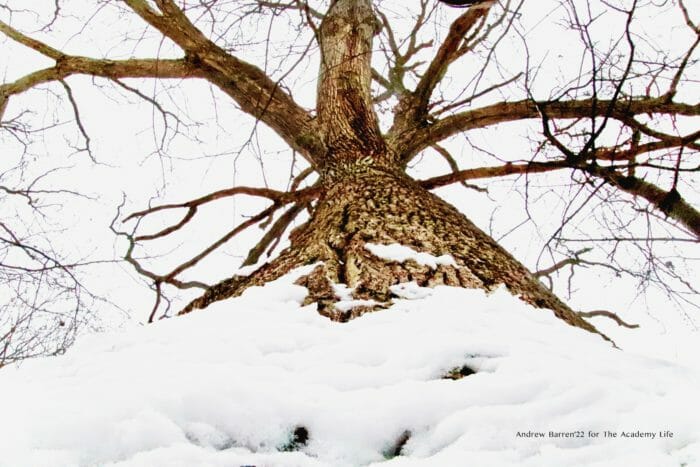Beauty abounds on Academy’s campus. (Andrew Barren’22 and Katie Rankin’22/Staff)
Over the past several years, Academy has implemented many programs and initiatives, all advocating for environmental conservation and awareness in our school community. These efforts range from the revamped student-run Service Board recycling program to the Dining Hall’s food pulper system, which has reduced food waste eightfold.
Members of our school community worked this past year to accomplish the latest environmental awareness initiative: official designation as an arboretum, which would bring recognition to the diverse collection of trees present on our campus.
In early December 2017, the idea of Academy becoming an arboretum was first broached to students. A year later, Academy’s application to gain arboretum status was approved, making Columbus Academy the first to school in Central Ohio to gain such a designation.
Arboretum designation allows Academy to expand its environmental awareness program outward to the greater community. As an arboretum, Academy would open its campus to the general public at least once a year for a day full of environmental programming.
In addition, accreditation for a Level I arboretum also entails devising an arboretum plan, creating an organizational or governance group, having over 25 identified and labeled trees, and volunteer support.
The process of applying for arboretum status was carried out by 8th grade science teacher, Ruth Giglio, who organized a committee consisting of 7th grade science teacher Alison Gorsuch, 8th graders Ashley Tu and Maren Lawrence, and 7th graders Eleanor Schroeder and Caroline Caldoney. The committee met once per letter day rotation to complete the application and also to label and identify the 25 trees needed to receive accreditation.
The species identified in a tree inventory by Ahlum & Arbor Tree Preservation ranged from flowering plum to white pine, collectively well-representing the diversity in Academy’s woods. A full list of the 25 species are listed at the bottom of this article.
To enhance the experience of visitors, the committee created tree tags identifying the various tree species with a QR code found on each. By scanning the QR code, visitors can access Plantsmap.com to enjoy a “self-guided educational experience,” according to Giglio.
For upper school students, outdoor learning is emphasized through Mr. Davis’s Freshman Biology Community Ecology Project and other outdoor learning activities. Despite these efforts, as a school we often take our beautiful campus for granted and neglect to properly acknowledge and learn about the different species of plant life and wildlife thriving on school grounds.
The arboretum’s potential for community impact, within Academy and to visitors of our campus is clearly articulated in our school’s Mission Statement: The primary goal of the arboretum at The Columbus Academy is to highlight the various species of trees, shrubs and plants that grow on our 231 acre campus. It aims to promote and cultivate faculty, staff, student and visitor appreciation for the botanical diversity found on our campus. It also aims to provide enjoyment and inspiration to all those who visit. The arboretum aims to help promote wellness to all those who visit.
The arboretum community plans for the first community day to fall on Arbor Day in April.
Tree species:
White spruce
Flowering plum
Red maple
White pine
Box elder
Willow
Amur maple
Black maple
Crab apple
Pin oak
Bur oak
Swamp white oak
Red oak
Scarlet oak
Shingle oak
Chinquapin oak
White oak
Chestnut oak
Black oak
Shumard oak
Sugar maple
Hackberry
Green ash
Black walnut
Black locust








